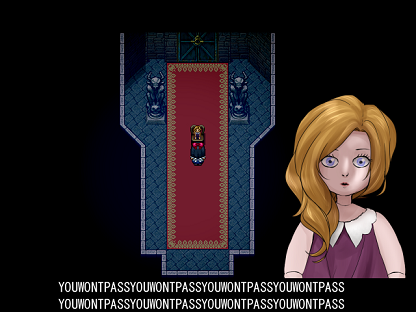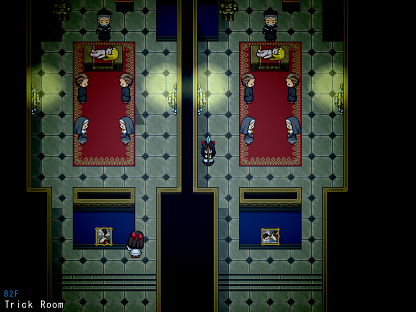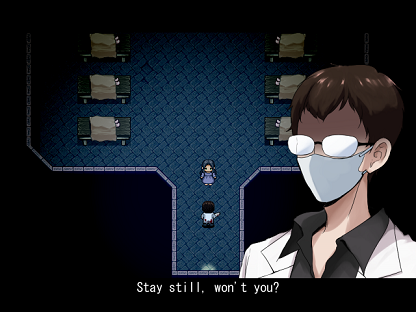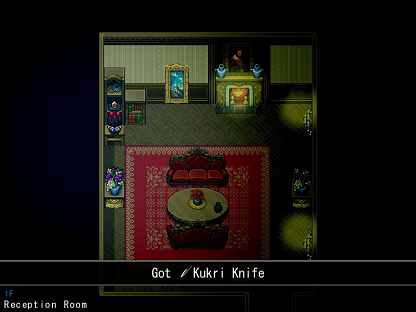EDITOR'S NOTE:
Huh? I thought we'd already done Corpse Party, why are you... Oh. This isn't Corpse Party. This is a different game. OK, fine, as long as you're sure. Our screenhots all come from the 2016 Steam version of the game (except when they're not and they're from the 2012 original because we talk about that one afterwards) and they were taken using the Steam interface in Windowed mode (playing in Full Screen distorted everything and we wanted to keep the proper aspect ratio, and that last bit makes us sound like we know what we're talking about, doesn't it, God we don't). You can click them to make them bigger. Oh, and we highly recommend internalising the tips we give for getting the game to work properly, as we wish to spare you the hell of going to the Steam Discussion forums to find your answer. We're your friends. We're trying to help you.
Also, in case you somehow skipped our warning...
SUPER-MINOR NOT-REALLY-SPOILERS SPOILERS AHEAD. AND AT LEAST THREE GORY SUPER-SCARY SCREENSHOTS.
YOU WERE WARNED, PUNKS.
Also, THIS IS BASED ON THE 2016 VERSION OF THE GAME, WHICH NO LONGER EXISTS
(We'll get on to reviewing the 2020 remake at some point in the future.)
Time for another RPG-style game that's actually a horror game!
One lucky enough to get a 2016 remake and release on Steam, no less.


Mad Father is one of a handful of Japanese freeware horror games created in 2012 via the use of various RPG-making tools that probably weren't designed with horror in mind. The other two famous ones from this year- Ib by kouri and The Witch's House by Fummy- were made in RPG Maker 2000 and RPG Maker VX respectively, but Mad Father, created by Sen and distributed by the circle Miscreant's Room, instead was made with WOLF RPG Editor, a free alternative to RPG Maker that's sadly limited to Windows. The original version was translated by vgperson but more recently, the game was given a spruced-up rerelease on both Steam and Playism, and this was my introduction to this charming little slice of horror RPG-lite action. In an opulent mansion somewhere in Germany, Aya lives with her father and his assistant Maria after her mother's death, but she knows his secret- he's been performing horrific experiments on live humans in the basement. She tries to ignore it (and the screams) until one night all hell breaks loose, as her father's victims come back as reanimated corpses seeking revenge In spite of his actions, Aya sets off to rescue him and escape alive, aided by the travelling salesmen Ogre, an unnamed but helpful blonde ghoul, and her own wits and courage.
At the offset, the game's mechanics are going to feel pretty familiar to anyone who's played games in this style before- that is to say, Corpse Party or the like. You've got eight-way movement, a menu button, an examine/talk button, and that's your lot. However, the game has a habit of changing things up now and then for a refreshing bit of variety- near the end of the first area you get a mini-chainsaw (complete with chain-roaring sound effects) which has a variety of uses (one of which, you will be surprised to find out, is not combat), little QTE events that are surprisingly generous with the time given to you, stealth segments (which are mercifully brief), segments with enemies where you can only avoid them, and even a little jigsaw puzzle for some light relief (that, on repeat playthroughs, you can skip). The variety on display is welcome, but generally you'll be looking for items to either unlock new rooms or find more items, with puzzles to solve along the way, and Mad Father hits that sweet spot of having puzzles that make you think but don't resort to pixel-hunting. Speaking as a person who is absolutely terrible at adventure games, most of the solutions seemed pretty logical and common-sense, as long as you examine your surroundings.


As for its visuals, most of the game's assets are from free resource packs (some that freeware horror veterans will recognise- one girl's sprite is the same used for Viola in The Witch's House, and a music track shows up in the storybook video in Ib) but it uses those assets remarkably well to create both the luxurious mansion and the labyrinthine laboratory. A big element of this is the lighting- most places in the game are dark, so while Aya can usually see most of the screen, the peripheries tend to be shrouded in darkness. It's never quite to the extremes The Witch's House goes to where seeing anything is a strain on the eyes, but it helps add atmosphere and a sense that you're mostly alone in this creepy place. It also does the common trick of having things happen by themselves, such as tables falling over or bloodmarks appearing on walls, but its usage here is neat- most of the time, the game will not stop to point it out, as it does in other games. As a result, you'll find yourself constantly second-guessing and double-checking things- did that doll just get up? Is there really a hanging corpse in that room across the way? It's a common trick, but it's done very well here, giving you the feeling that you need to have eyes in the back of your head at all times if you want to see every detail.


The plot is fairly straightforward and the path to the end pretty linear, but Aya's gotta do some pretty horrible things to get to her father, and while it gets a little goofy right at the very end, I dug it. You have a constant motivation to move forward (even if some of that is 'just what is Aya's dad doing in that lab?'), there's a strong sense of atmosphere and dread, and there's little clues here and there for what the game's leading up to. In particular, there's a lot of detail for those who want to examine everything (especially if you decide to go back to previous rooms, some things change!), and there's a lot of charm in the side characters you can optionally help out or talk to. This extends to the point where a second playthrough is recommended- not only do new details appear after you beat the game, but there's plenty to see that you'll probably miss the first time around. The game also encourages this with the hidden gems- 21 of them are strewn across the game and are needed to unlock a bonus story and the museum mode, so it's worth seeking them out, as many of them require you to help out the aforementioned optional characters. Aya herself might seem like a little too easy to pigeon-hole into the 'terrified horror game heroine' archetype, but she has these little moments, both in dialogue and what you have her doing, that show she's a resilient, tough lil' kid, such as her reaction to an important item being stolen, and how she talks to a particular gatekeeper. It's nothing revolutionary, but manages to scratch that 'slightly hokey horror movie' itch, and the twists right at the end make sense if you pay enough attention...
Finally on this note, for scares, the game is mostly banking on its atmosphere, but with a few jumpscares peppered here and there, such as a lady with bleeding eyes suddenly greeting you in your mom's bedroom. There's also some cutaways to CG artwork, which aren't particularly gory but plenty unnerving. The game does a lot with a little in this regard, and I'd quite happily put it into mid-level horror territory- not super-intense, but definitely unsettling. The only element here that really grated was Aya's scream as it has a tendency to play every time you die- I eventually got in the habit of muting it. Overall, the game made me jump more than a few times, and while it will not terrify you to your core, its unsettling and unseemly atmosphere really hit the mark.


What's noteworthy is that Mad Father is considerably less player-hostile than you might think, and there's a lot of concessions to make getting through the game as painless as possible. Critically, items of interest have a ! appear above Aya's head (and a sound effect after it was patched in) when you step near them, so pixel-hunting is not an issue. Enemies are rare, but a health meter appears when they're in play so you know when to tread carefully, and while there are a few chase sequences that end in one hit, these don't really appear until near the end of the game, are telegraphed, and the most difficult one even has a savepoint directly before it. This is especially worthy of praise compared to The Witch's House, which has a habit of springing chases on you without warning and are much, much fiddlier to actually survive (while I played the whole of Mad Father on keyboard, I had to break out the SNES pad to finish The Witch's House). Savepoints are quite generously placed too, and while it's a little haphazard as to when it's used, there's a checkpoint system for some of the harder parts like the stealth section and final chase which let you continue from the start of the scene rather than a savepoint. One final, very useful bit of assistance is the chance to return to the starting room just before the point of no return in the game, allowing you to mop up any missing gems if you so wish (and a similar warp point exists to take you back to the end and finish everything up).


As far as criticisms go, the big one with the Steam release is, at launch, the game was a bit crash-prone, to the point where it delayed this review! The problems we encountered weren't quite as severe as some we've heard about, and it does seem most of them were sorted out a few months after release, but in case you're having problems, we were mostly experiencing crashes after continuing. Our steps were to change from Windowed to Fullscreen (worked for a while), then change Compatibility Mode to Windows XP SP2 (worked for a while), then changing App Locale to English (seems fine now). I imagine a lot of this is down to the WOLF RPG Editor which seems to be a bit hit-and-miss in terms of working as intended (and you''re outta luck if you're on Mac), which is a real shame. I am being a little lenient on the game in this regard, though, as the developers have worked on it, and there is an alternative version to play if it absolutely doesn't work. If it had progress-ruining glitches in the game itself, that'd be a different story.
Other issues aren't quite as severe, but definitely worth noting. In rare circumstances enemies can trap you against walls meaning you'll inevitably die- though this is rare, it can be frustrating especially if you're like me and put off saving when you can. Additionally, if you're looking for a challenge then this is not the game for you, as it;s straightforward, designed to make sure the player gets to the end rather than have to struggle. I'm OK with that, but it's worth noting. The one difficult part, in a roundabout way, is an item needed for the true ending, can be missed and require you to look at something twice, something you're not required to do elsewhere. Once you have that item, the game guides you where to use it, but it's definitely the most obtuse part of the game, which is a bit of a shame. Finally, story-wise the game is very reliant on flashbacks so I hope you like sepia-tone cutaways. One could argue they slow the pacing of the story, but I felt they just about get away with it as, without spoiling too much, these flashbacks aren't always from Aya's perspective, and even the ones that are do their best to fill in the gaps and provide clues to where the story's eventually headed.


It might be a smidgen unfair, given that only this one was given the Steam makeover, but of those three freeware Japanese horror RPG-likes released in 2012- that's this, Ib and The Witch's House- I'd firmly put Mad Father at the top followed very closely by Ib, then The Witch's House a distant third. Ib has a similar design philosophy of being as easy to get through as possible to tell its story, and it's also quite visually distinct (it comes recommended too) but something about Mad Father hooked me in enough to actually play through it three times. Perhaps its because of its horror being very traditional, and going all-out with it- the restless dead, a foreboding and extravagant mansion hiding a deadly secret... I definitely have a weakness for that kinda stuff. The brevity and accessibility of the game (when it wasn't crashing, arf, arf) is a big factor too, as it served as a really nice 'cool-down' game after playing arcade games and the like (well, as much as a horror game can count as a 'cool-down' game). I've become quite a fan of these 'short form' games in recent years, and this has firmly established itself as a strong entry in the genre. Recommended.
For making me question how safe it is to give a small girl a mini-chainsaw, Mad Father is awarded...

In a sentence, Mad Father is...
A short, fairly sharp little slice of horror.
And now, it's that time, folks!
EXTENDED PLAY!

Now, our review is based on the 2016 remake of the game, but what about the free version from 2012?


The original game, as released for free by Miscreant's Room, is mostly the same as the remake. The most obvious difference is in the visuals, as the game was given a fresh lick of paint, mostly the environments getting new tiles and details. One change that may be a bone of contention is that the original game is a lot darker- you don't get much light around Aya, and some areas like the storeroom are in almost total darkness. On the one hand, this does make the whole thing feel like it's taking place at night more clearly, but it has the side effect of sometimes making it hard to know where you're going, and overall makes it feel a little too much like The Witch's House, which had similar low visibility. Personally, I prefer the 2016 version's visuals- not just in terms of lighting, there's a lot more detail everywhere- but it might be a case of personal taste. It would appear that even earlier versions of the game, as seen on vgperson's page, had yet more graphical differences- the portrait art for Aya is very different there!


There's also a few layout changes, with some rooms having slight adjustments here and there, although one big divergence is after the morgue in B1, where a spectre will lead you to a hidden route that leads to a shortcut to the west hall on the first floor. This spectre continues to lead you to an important room (which is how it is in the 2016 game, you just find the spectre elsewhere), but this route may have been removed as it was redundant, seeing as the storeroom serves a similar shortcut purpose. Some areas, like the changing room, are very different (with a puzzle even changed- a tightly-sealed box becomes a giant spider web in the 2016 version) and others, like the bathroom, are greatly expanded (in the 2016 version, you can even go into the toilet). Finally, the 2016 version adds in QTE-style button chains (all directions) that replace some, but not all, of the 'mash the button' sequences from the original (the corpse in the painting is changed to a button-chain, for instance, but not the doors you have to force open). Two big concessions missing from the 2012 version are checkpoints (you always continue from your last save) and the ! and sound effect that appears when items of interest are around (gotta use your noggin this time).
Overall, I'd say the 2016 version is the definitive release of Mad Father- when it's working- but if you'd prefer the nighttime aesthetic of the original, you're welcome to try. It's also a viable alternative if you have problems with the Steam release, just bear in mind there will be differences.

... To be honest, in the time it took you to read this, you could've made it through the prologue of Mad Father, at least.
We tried to cut it down, we swear! But we had a lot to say. Do forgive us.
Next time: At least two hour's worth of text on Alleyway. Or something.


















